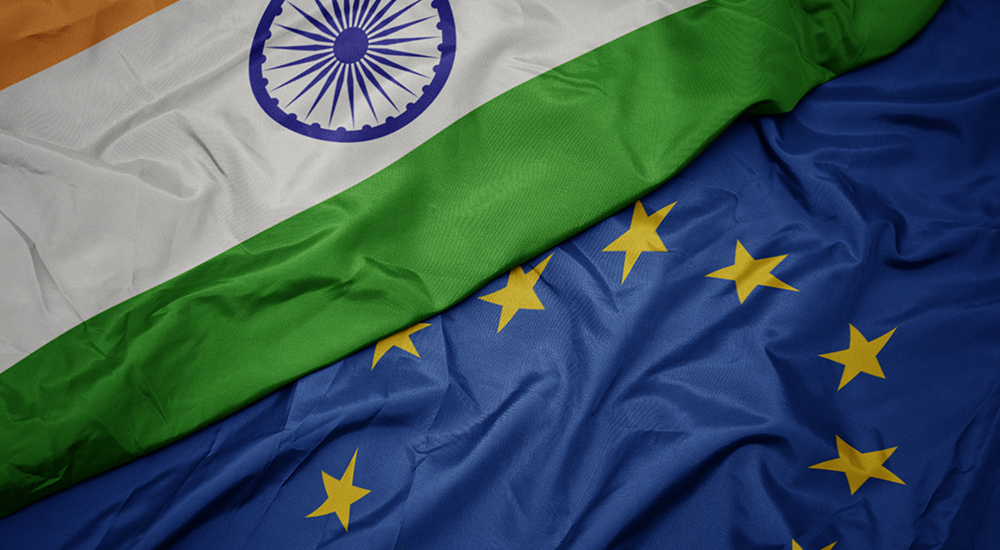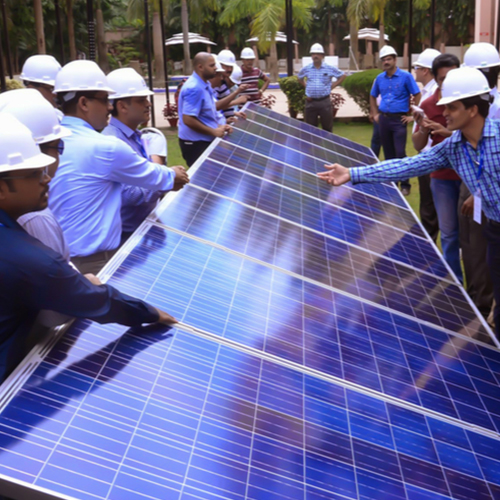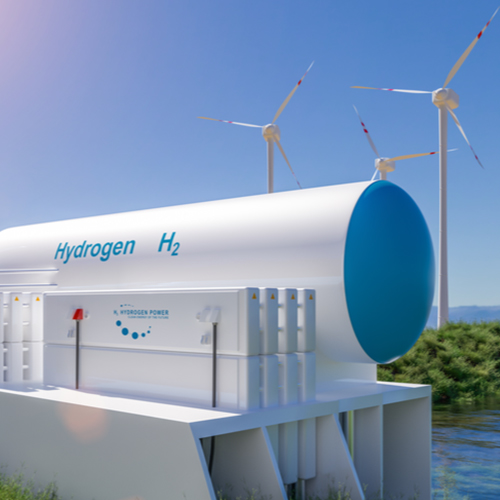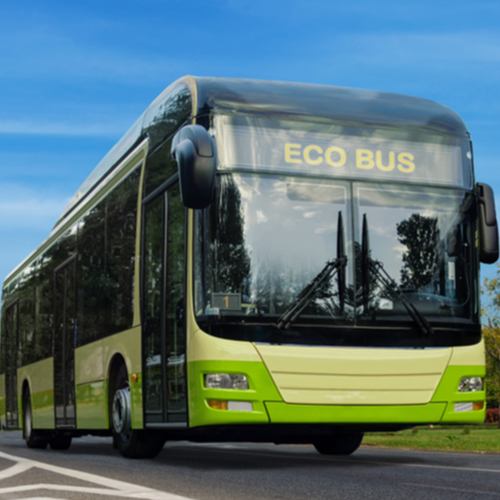India and the European Union (EU) are key players in the field of international climate diplomacy. This briefing note on the India-EU Track II dialogue details a range of areas for potential cooperation between India and EU to further goals of climate action and sustainable development.

India and the European Union (EU) are important players in the field of international climate diplomacy. The EU is one of the most committed regions for climate mitigation, with domestic legislation converging towards a target of net zero emissions by 2050. India too has instated key ambitious programs including that of renewable energy expansion in the power sector, National Cooling Action Plan, and a National Clean Air Plan among other climate commitments. The ramifications of COVID-19 coupled with the onset of extreme climatic events, has reinforced the precarious interlinkage between economic and ecological factors at the global level. There is greater consciousness of global implications of anthropogenic actions.
There are strong commercial, financial and industrial ties between India and the EU and both have a traditional interest in the UNFCCC process. The India-EU dialogue (supported by CIFF), jointly curated by TERI from India and IDDRI along with ECF from EU side, aims to further a climate-focused dialogue between the two regions.
The dialogue aims to establish a high-level, informal forum for exchange on issues of domestic climate change policy and international climate diplomacy, consisting of influential and independent participants from EU and India.
The dialogue is envisaged to span over two years, regularly engaging with experts across the spectrum on the most pertinent areas of discussion including through small working groups. These will include areas such as mobilising finance for climate action, pathways for long-term strategies and building resilience and adaptive capacity. For each session within the series, we will invite and engage with subject matter and policy landscaping experts from the Indian side. Some of the areas of discussions have been discussed in the note:
Energy transition

Given the macroeconomic context and considering its growth pathway, India is expected to face increase in energy demands more than those of any other country over the next two decades[1]. This will directly result in an increase in GHG emissions. While India has been adding large scale renewable power to its energy composition as part of its commitments; the deployment of the same, a sustainable and just phase out of coal and improved financial health of distribution companies are some necessary next steps to be made in the context of energy sector. Some of the positive developments have been declining solar photovoltaic costs in India, which have dropped from $0.30/kwh to less than $0.05/kwh 2010-2019,[2] with recent reports of <$0.03/kWh, and India has such good solar insolation[3]. The declining cost of solar PV is reassuring of the scale of installation of solar power. However, for a lasting transition to RE away from fossil fuel will require declining costs of storage as well. This further requires planning to deal with solar diurnal variability (e.g., overnight firm clean power backup is necessary, possibly using hydrogen generated during the day). Lastly, a clear pathway out of coal is a key missing piece in the current Indian energy transition. This pathway would need to take a just transition perspective accounting for the risks and opportunities related to jobs, stranded assets and regions. The experience from the EU side will be vital to explore optimal means of undertaking the transition in this sector.
Potential for EU-India cooperation: Both the EU and India are embarked on pathway to decarbonize and grow their electricity system to allow transport, building and light industry electrification. India has announced an ambitious target of setting up 450 GW of renewable energy by 2030 and is working on a roadmap to achieve this target. The EU led many of the early efforts to build demand for wind and solar PV and experience from these can be instrumental for catering to India’s needs for clean energy generation for clean development. India has also announced its USD 214 million (INR 1500 crore), towards renewable energy development and National Hydrogen Mission. The EU’s experience from its Hydrogen Alliance will be instrumental for India. The two regions could collaborate on these and also work together on building open-source utility and system knowledge for how to build and operate highly variable renewables power systems, e.g., how to ensure firm clean power economically - through more transmission, demand management, batteries, hydrogen, etc. In addition, collaboration on energy-efficient appliances and in particular low-carbon cooling could contribute to reducing India’s peak electricity demand.
Industry transition

A similar transition towards greener means of production for harder-to-abate sectors will be a crucial determinant for attaining a low-carbon pathway. There is a strong interest in India in maintaining a self-sufficient and clean steel industry. This has sparked interest in exploring technologies and means of minimising emissions from hard to abate sectors. Technologies such as hydrogen based direct reduced iron in electric arc furnace (DRI EAF) for steel making and expanding use of hydrogen in other hard to abate sectors such as cement, aluminium, metallurgy and chemicals, with the hydrogen made in a near GHG-free way, is an important way forward. In the interim, even brown hydrogen is a welcome technology. Similarly, CCUS is also critically important to sequester unavoidable emissions.
India and Sweden’s leadership in the Industry Transition launched at the 2019 UN Climate Action Summit lays out important pathways. Expectation is that India plays a key role globally (not just for its own domestic decarbonisation) in the transition of harder to abate sectors, including through a club mechanism. Greening of sectors such as steel and cement, which are essential for large-scale domestic construction as well as exports, require access to best available technology and means of financing the same. Further, industry transition is crucially dependent on energy transition, so that power generation within the industry can transition away from coal to clean electricity. Another expectation is also that global trading partners should support and cooperate each other rather than try to outcompete each other on the ground of emission intensity of globally traded products.
Potential for EU-India cooperation: Both the EU and India face the challenge of maintaining their industrial capacity while eliminating coal combustion to atmosphere. There are common opportunities in developing hydrogen direct reduced iron steel making and targeted applications of CCUS in cement making. EU and India can also share mutually supportive perspectives on avoiding use of competitive instruments where industries adopt climate friendly measures. The two regions could work on shared research, development and early commercialization efforts, e.g. through lead markets enabled by contracts for difference[4].
Transport

The transport sector of India is the third most greenhouse gas (GHG) emitting sector, with the major contribution coming from road transport. Out of the total carbon dioxide emissions in India, 13% come from transport[5]. Of these 90% of emission come from road transport[6]. The logistic and freight transport sector is key for India and there is strong political will to develop rail freight in India as a component of deep decarbonization.[7] Furthermore, India has one of the largest rail company in the world. In July 2020, Indian Railways announced that the national transportation system will be a net zero carbon emitter by 2030. This would mean eliminating emissions of 7.5 million tonnes of CO2 equivalent each year[8]. The railways are targeting to improve energy efficiency and replace fossil fuel sources with renewable energy sources to achieve net zero carbon emissions by 2030.
As for decarbonising road transport, shift to electric vehicles for short and long-distance travels is essential. Strengthening the favourable enabling environment for a transition towards electric vehicles and developing the requisite infrastructure will also be required in this area. The EU as well has had a strong push towards decarbonizing its transport sector through revising the fuel and CO2 standards. For example, in April 2019, the EU approved a new fuel economy standard for cars and vans for 2021‑30 and a CO2 emissions standard for heavy-duty vehicles (2020‑30), with specific requirements or bonuses for EVs[9].
Potential for EU-India cooperation: India has one of the largest rail company in the world and the EU has the most advanced rail technology providers with Alstom and Siemens. Economic cooperation o furthering the greening of railways by rail electrification, multimodal platforms, renewal of electric locomotives and other train communication systems, will further dissemination of low-carbon technologies in this sector.
Mobilisation of finance

The sectors highlighted above hold immense importance for India’s transition and are closely interlinked. For example, a shift away from coal to clean electricity is essential for enabling a clean transition for the industry. The same will hold for decarbonizing the transport sector. Potential of hydrogen to be used as a clean source of energy in each of these sectors is an area of keen interest that can be explored between experts from India and EU. However, at the core of these is the access to best available technologies and accessing scalable finance. This has been an area of priority not just with the onset of the pandemic and urgent need for financing a green recovery, but also with keeping in mind the goal of mobilizing USD 100 billion every year by 2020. Exploring mechanisms and instruments to channel finance for large-scale decarbonization projects will be an area of interest for India. Greening the domestic financial system and accounting for climate risks are also areas where India stands to gain from EUs experience. Lastly, mobilizing scalable finance for increasing adaptive capacity and resilience is also an essential area of exploration.
Potential for EU-India cooperation: Both India and EU have been involved in the launch of the International Platform for Sustainable Finance (IPSF), amidst other bilateral working groups such as that on sustainable finance between India and the UK. In the context of India’s ambition to set up 450 GW of renewable energy by 2030, both EU and India have an opportunity to scale up the required investments through innovative measures. Instruments, policies and frameworks must be explored to identify means of reducing the cost of finance for developing countries. Further, the need for an agreed definition of sustainable finance to standardize the green investment taxonomy could be vital in encouraging the private sector to make more investments in sustainable finance. Advancing on such taxonomy for mobilizing more green finance in India can gain from the EU experience in the same.
Adaptation and resilience

According to the Global Risk Index 2020, India ranks fifth among the vulnerable countries to climate change. Given that the country is heavily dependent on climate-sensitive livelihoods (agriculture, fishery, livestock, etc.) for its development, there is a need to enhance vulnerability assessment in the country. India’s vulnerability needs to be mapped across the various geographies (marine, high-altitude Mountains, arid and semi-arid areas, river plains, etc.), demographics (urban and rural vulnerable, employment, education, income, gender) and economic sectors (agriculture, industry, etc.).
On this basis, it is paramount that there is a need for adaptation and building resilience. This will aid in reducing vulnerability of people, infrastructure and the economy and enables economic growth. In order to protect its people and to meet the SDGs, India holds a large interest in global, national, subnational and local risk assessment for solid climate adaptation and resilience planning in multi-sector approaches. This can be achieved through mainstreaming climate risk management within Indian regulations like development plans.
Despite its significant vulnerability to climate change impacts India is not a prime receiver of international adaptation finance. India has established a National Adaptation Fund for Climate Change (NAFCC) to meet adaptation costs for protecting the most vulnerable. Against the background of increased extreme events and India’s large-scale affectedness, further international – as well as bilateral – support beyond the existing levels is urgently needed with greater direct access and eased modalities.
Coalition for Disaster Resilient Infrastructure (CDRI): The multi-actor initiative, launched by PM Modi in 2019, seeks to promote the resilience of new and existing infrastructure systems to climate and disaster risks. It is the international forum for India to demonstrate leadership - next to the International Solar Alliance (ISA) and the global Leadership Group for Industry Transition (LeadIT).
Potential for EU-India cooperation: On adaptation, EU-India cooperation could focus on- data collection and risk assessment tools, multi-stakeholder adaptation planning, implementation of resilience building in selected areas (extreme weather, water scarcity or flood prevention, heat stress), and international collaboration around resilience, including finance. De-risking adaptation and resilience finance – particularly for disaster resilient infrastructure – and financing sectoral action at the sub national level could be of interest as well as innovative risk finance instruments.
The briefing note has been authored by:
1. Ms Ritu Ahuja, Research Associate, Centre for Global Environment Research, TERI
2. Ms Alexandra Deprez, Research Fellow, International climate governance, IDDRI
3. Mr Abhishek Kaushik, Associate Fellow and Area Convener, Centre for Global Environment Research, TERI
4. Ms Mekhala Sastry, Research Associate, Centre for Global Environment Research, TERI
5. Ms Lola Vallejo, Climate Programme Director, IDDRI
Footnotes:
[1] https://www.ft.com/content/498569d4-6208-4e07-8439-8aaeeca4cdff
[2] https://www.irena.org/Statistics/View-Data-by-Topic/Costs/Solar-Costs
[3] https://mercomindia.com/india-record-lowest-solar-tariff/#:~:text=The%20Solar%20Energy%20Corporation%20of,)%2C%20according%20to%20Mercom's%20sources.
[4] https://www.iddri.org/en/publications-and-events/study/decarbonising-basic-materials-europe
[5] https://www.itf-oecd.org/node/25230
[6] https://www.statista.com/statistics/1051485/india-distribution-ghg-emmission-from-transport-sector-by-type/
[7] This willingness is namely illustrated by Deep Decarbonization scenarios highlighting a rail modal share for freight transport going up to 50% of total km by 2050
[8] https://www.unep.org/news-and-stories/story/its-full-steam-ahead-green-indias-railway-network
[9] https://www.iea.org/reports/electric-vehicles

